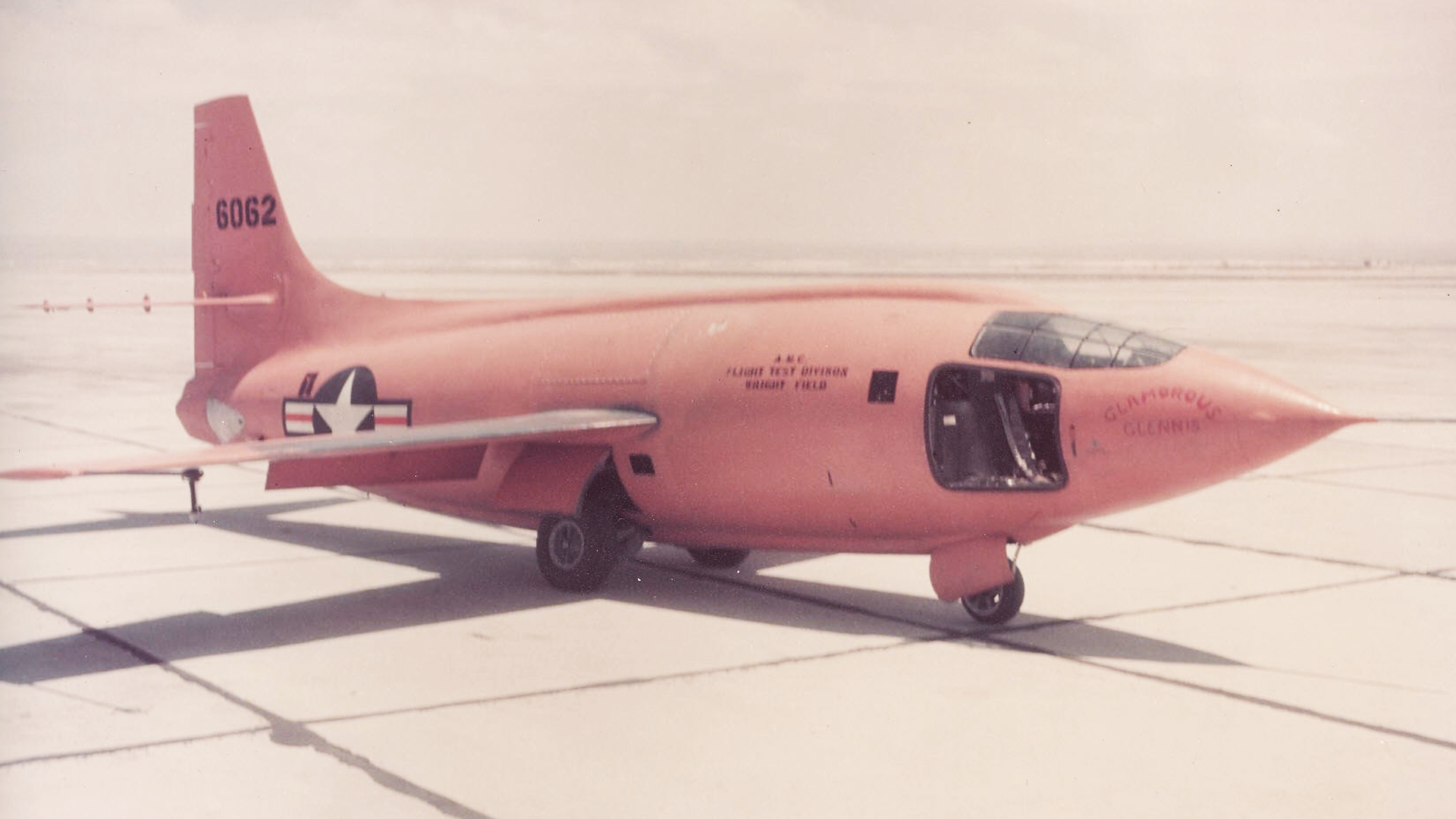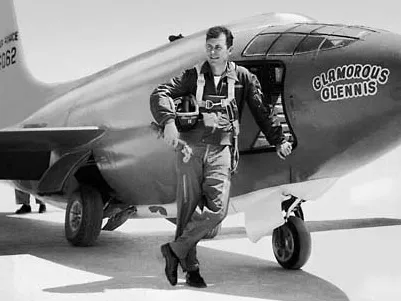Chuck Yeager Breaks the Sound Barrier

The orange Bell X-1 rocket plane, Glamorous Glennis, in flight over the desert.
What Happened?
Chuck Yeager was a decorated World War II fighter pilot who volunteered to test an experimental rocket plane called the Bell X-1. Test pilots were like scientists in the sky: they gathered data with their hands, eyes, and instruments, then reported every detail to engineers on the ground.
The X-1 looked like a .50-caliber bullet for a reason—bullets were known to be stable at supersonic speeds. Its thin, strong wings and a precisely adjustable horizontal stabilizer helped control the aircraft as air flowed differently near the speed of sound.
On the big day, a B-29 carried the X-1 up to about 25,000 feet and released it like a high-flying laboratory. Yeager ignited the rocket engine, climbed to around 40,000 feet, and carefully nudged the plane faster as his Mach meter crept toward 1.0—the point where an airplane matches the speed of the sound waves it creates.
Many experts warned that shock waves near Mach 1 could make the controls useless and tear an airplane apart. But engineers had recently improved the X-1’s adjustable stabilizer, letting Yeager trim the tail in tiny steps to keep control as he approached and then passed through the critical speed zone.
At about Mach 1.06, Yeager slipped beyond the sound barrier. On the ground, listeners heard a sonic boom—a thunder-like clap made when an object outruns its own sound waves—while Yeager reported a surprisingly smooth ride above the barrier that had seemed so dangerous.
The flight lasted only minutes, but the knowledge it produced was huge. The X-1 program proved that the 'barrier' was really a knowledge problem: with the right shapes, materials, and control systems, pilots could fly safely in the transonic and supersonic ranges.
Supersonic research immediately shaped the next generation of aircraft, from early Cold War jets like the F-100 to safer, more efficient subsonic airliners. Even if most passenger planes don’t fly faster than sound, the lessons learned at Mach 1 improved the design, stability, and safety of planes we use today.
Yeager, who named his plane 'Glamorous Glennis' after his wife, kept testing advanced aircraft for decades and later became a brigadier general. His breakthrough reminds us that progress comes from careful teamwork: courageous pilots, inventive engineers, and meticulous data turning doubts into discoveries.
Why It Matters
Breaking the sound barrier showed that limits in science are often challenges to be understood, not walls we must accept. Yeager’s flight turned fear into facts and launched a new era in aeronautics, leading to safer planes, faster jets, and a deeper understanding of how machines move through air—key ideas that still guide aerospace and space travel today.
?
What is a 'sonic boom,' and why do people on the ground hear it after a supersonic plane passes?
How did the X-1’s bullet-shaped fuselage and adjustable stabilizer help it fly faster than sound?
Why did engineers use rocket power and a B-29 launch instead of taking off from a runway?
What new problems might pilots and engineers face when going from supersonic to hypersonic speeds?
How did knowledge from the X-1 program make today’s (subsonic) passenger planes safer and more efficient?
Dig Deeper
A clear explainer of shock waves, Mach numbers, and why sonic booms happen when aircraft go supersonic.
Related

Aerodynamics and the Forces of Flight
Weight, lift, thrust, and drag—these are the invisible forces every pilot and engineer must master to conquer the sky. From paper airplanes to rocket launches, aerodynamics is the science behind every flight.

The Scientific Method
What do curiosity, logic, and a good notebook have in common? They're the foundation of the scientific method—a system that turns wonder into wisdom.

Classification: How We Make Sense of a Wild and Wonderful World
Before we can protect nature—or understand it—we have to organize it. Classification is the science of finding patterns, drawing lines, and asking: What belongs where, and why?
Further Reading
Stay curious!
